

BJC - Beauty and Joy of Computing. 15+ Ways of Teaching Every Student to Code (Even Without a Computer) According to Code.org, 90 percent of parents in the U.S. want their children to learn computer science—it will be crucial for many jobs in the near future—but only 40 percent of schools teach it. Critics claim that it is mainly the more affluent schools that offer computer science courses, thus denying those who attend poorer schools the chance to learn necessary skills. BBC Bitesize - KS3 Computer Science - Introduction to computational thinking - Revision 1. Google for Education: This section is provided to help teachers quickly learn the basics of Computational Thinking (CT), and determine how to incorporate it into their own teaching and lesson plans.
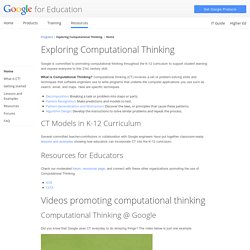
Why do this? There is a hypothesis that CT is a critical skill for 21st-century students. The hypothesis states that not only is this skill critical for our students and ultimately our population to use computing and technology effectively to solve problems. CT also supports and enhances the learning of more traditional curriculum and can be infused into any topic. How to start? Another aspect of CT is "data skills", that is, being able to collect, analyze and represent data in meaningful ways.
Where to apply it? When a teacher can connect the data skills used in social studies or math with the same data skills used in science, it reinforces their importance, and helps students understand that it’s the same set of skills applied in different domains. Creative Computing Online Workshop. Scratch in English and Social Science Classes: An Interview with Rick Ashby of Douglas S. Freeman High School. Rick Ashby is passionate about using Scratch to teach English, History, and Civics.
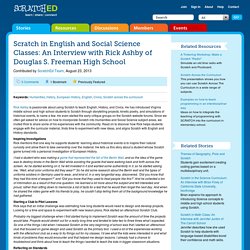
He has introduced Virginia middle school and high school students to Scratch through storytelling projects, kinetic poetry, and simulations of historical events, to name a few. He even started the early critique groups on the Scratch website forums. Since we often get asked for advice on how to incorporate Scratch into Humanities and Social Science subject areas, we invited Rick to share some of his experiences with the community. The Nature of Code. Hello!
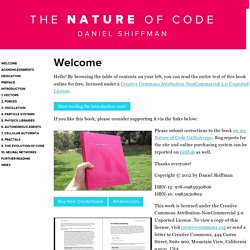
By browsing the table of contents on your left, you can read the entire text of this book online for free, licensed under a Creative Commons Attribution-NonCommercial 3.0 Unported License. Start reading the introduction now! If you like this book, please consider supporting it via the links below: Please submit corrections to the book on my Nature of Code GitHub repo. Bug reports for the site and online purchasing system can be reported on GitHub as well. Thanks everyone! Copyright © 2012 by Daniel Shiffman This work is licensed under the Creative Commons Attribution-NonCommercial 3.0 Unported License. All of the book’s source code is licensed under the GNU Lesser General Public License as published by the Free Software Foundation; either version 2.1 of the License, or (at your option) any later version.
Raspberry Pi Temperature Sensor. In this tutorial, we will be building a circuit to connect a temperature sensor to our Raspberry Pi, and writing a program to read the sensor data.
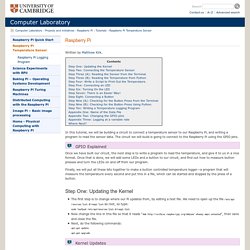
The circuit we will build is going to connect to the Raspberry Pi using the GPIO pins. GPIO stands for General Purpose Input/Output. General purpose because all they are is simple connections that can be either high or low, a binary choice. This means we can easily do things that involves binary choices, and it will still be nice and simple to understand what is going on. [1107.5216] Implementing and assessing computational modeling in introductory mechanics. Developing students’ computational modeling skills. I was asked to share my experience and thoughts on developing students computational modeling skills in large introductory physics courses.
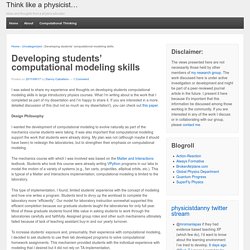
What I’m writing about is the work that I completed as part of my dissertation and I’m happy to share it. If you are interested in a more detailed discussion of this (but not so much as my dissertation!) , you can check out this paper. Design Philosophy I wanted the development of computational modeling to evolve naturally as part of the mechanics course students were taking. The mechanics course with which I was involved was based on the Matter and Interactions textbook. Microsoft Sends Engineers to Schools to Encourage the Next Generation. Photo SEATTLE — Leandre Nsabi, a senior at Rainier Beach High School here, received some bluntly practical advice from an instructor recently.
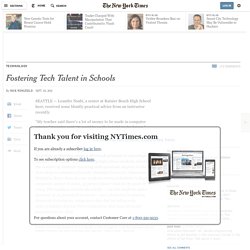
“My teacher said there’s a lot of money to be made in computer science,” Leandre said. “It could be really helpful in the future.” That teacher, Steven Edouard, knows a few things about the subject. When he is not volunteering as a computer science instructor four days a week, Mr. In doing so, Microsoft is taking an unusual approach to tackling a shortage of computer science graduates — one of the most serious issues facing the technology industry, and a broader challenge for the nation’s economy. There are likely to be 150,000 computing jobs opening up each year through 2020, according to an analysis of federal forecasts by the Association for Computing Machinery, a professional society for computing researchers.
%s The program started as a grass-roots effort by Kevin Wang, a Microsoft engineer with a master’s degree in education from Harvard. Mr.